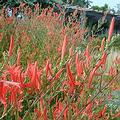 美國的景觀產業已享有了數十年的榮景,但是只有找到更環保的種植和銷售方法並支持可持續性發展的理念,這樣的榮景才能持續下去,美國苗圃和園藝協會的執行副總裁這般表示。
美國的景觀產業已享有了數十年的榮景,但是只有找到更環保的種植和銷售方法並支持可持續性發展的理念,這樣的榮景才能持續下去,美國苗圃和園藝協會的執行副總裁這般表示。
迪利伯(Robert Dolibois)是在10月8日在德州農工大學擔任國際花卉園藝學卓越系列講座的主講人時,提出上述觀點。
迪利伯表示他在華盛頓的組織代表了約2300家公司提供8000萬個美國家庭相關的產品和服務,但是他說這個產業面臨了一些相當重要的挑戰。
首先,過去15年來,這個產業是在嬰兒潮的帶動下而成長,但現在必須理解到,主要的消費群──中產階級已逐漸消失。
這個產業必須以現今18到30歲的Y世代為主要客群,因為他們現在正處於獨立生活的過渡期,但是景觀產業也必須拓展嬰兒潮世代對購買植栽和園藝的興趣。
「不論如何,我們必須逆轉現在植栽景觀比例在住家和商用地設計上相對於硬體景觀逐漸減少的趨勢。」
硬體景觀是使用非植物類的材料像是沙、碎石或是岩石來美化空間,懶得動手整理園藝或是在乾旱地區像拉斯維加斯等地的居民比較偏好像這樣的景觀裝飾。
迪利伯表示目前有一些新的方向,像是在奧斯汀,美國地景建築學會、強生夫人野花中心以及美國植物園的可持續發展地段合作案。
美國綠建築協會也對此計畫提供協助,並且預計在完成時將可持續發展地段的模式引入到其節能環保設計(LEED)的系統之中。
可持續發展地段方案在11月將會發行一本可持續發展景觀設計的報告供作公開評論,其中一小部分已經在10月7日美國地景建築學會年度會議上呈現。
德州苗圃和園藝協會協會在網站上有一個關於可持續性發展的討論區,網址如下:http://tnlaonline.ning.com/
The U.S. landscape industry has enjoyed decades of prosperity, but that will continue only if operators find more environmentally-friendly growing and selling methods, and embrace sustainability, says the executive vice president of the American Nursery and Landscape Association.
Speaking Wednesday at Texas A&M University, Robert Dolibois, delivered the keynote address for the Distinguished Lecture Series of the Ellison Chair in International Floriculture.
Dolibois said his Washington, DC-based organization represents some 2,300 companies that provide products and services to about 80 million U.S. households, but he said the relative good fortune of the industry faces crucial challenges that must be overcome for future success.
For one, the industry "has ridden on the back of the Boomer behemoth" for the past 15 years, he said, but now must realize that the primary purchasing population - the middle-aged households - are diminishing.
The industry certainly must pursue the Gen Y'ers - those who now are 18 to 30 years old - as they transition toward maintaining their own homes, Dolibois said, but the industry must also look for ways to extend the Boomers' interest in buying plants and landscape items.
"In all instances, we need to reverse an alarming trend of reducing the proportion of plant materials relative to hardscaping in residential and commercial design," he said.
Hardscaping is the use of non-plant materials such as sand, gravel or rock to landscape a space. It is preferred by residents weary of yardwork or those in arid urban environments such as Las Vegas who must decrease the amount of water they use to maintain their properties.
Dolibois said new programs such as the Sustainable Sites Initiative being developed in Austin in cooperation with the American Society of Landscape Architects, the Lady Bird Johnson Wildflower Center and the U.S. Botanical Gardens, can show the way.
The U.S. Green Building Council is lending its support to this project and anticipates adoption of the Sustainable Sites metrics into its LEED system once they are finished.
The Sustainable Sites Initiative will issue its next major report on sustainable landscape design for public comment in November. A preview was presented at the American Society of Landscape Architects annual meeting and trade show that concluded Tuesday in Philadelphia.
The Texas Nursery and Landscape Association has a sustainability discussion on its website, visit: http://tnlaonline.ning.com/
全文及圖片詳見:ENS

